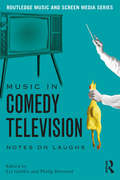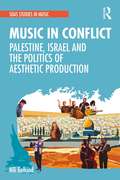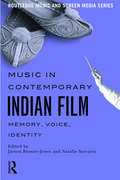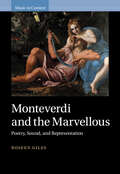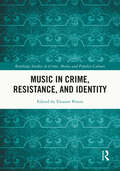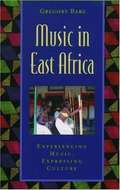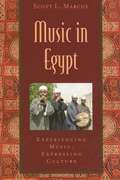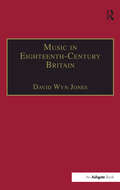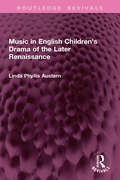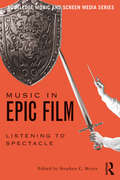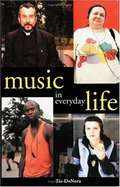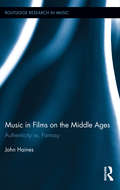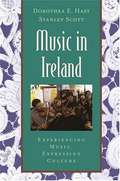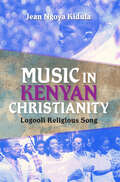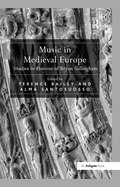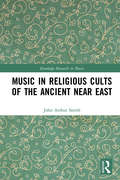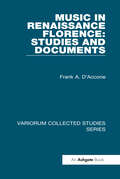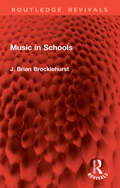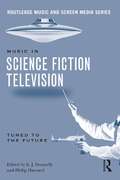- Table View
- List View
Music in Comedy Television: Notes on Laughs
by Philip Hayward Liz GiuffreThe study of television and music has expanded greatly in recent years, yet to date no book has focused on the genre of comedy television as it relates to music. Music in Comedy Television: Notes on Laughs fills that gap, breaking new critical ground. With contributions from an array of established and emerging scholars representing a range of disciplines, the twelve essays included cover a wide variety of topics and television shows, spanning nearly fifty years across network, cable, and online structures and capturing the latest research in this growing area of study. From Sesame Street to Saturday Night Live, from Monty Python to Flight of the Conchords, this book offers the perfect introduction for students and scholars in music and media studies seeking to understand the role of music in comedy onscreen and how it relates to the wider culture.
Music in Conflict: Palestine, Israel and the Politics of Aesthetic Production (SOAS Studies in Music)
by Nili BelkindMusic in Conflict studies the complex relationship of musical culture to political life in Palestine-Israel, where conflict has both shaped and claimed the lives of Palestinians and Jews. In the context of the geography of violence that characterizes the conflict, borders and boundaries are material and social manifestations of the ways in which the production of knowledge is conditioned by political and structural violence. Ethical and aesthetic positions that shape artistic production in this context are informed by profound imbalances of power and contingent exposure to violence. Viewing expressive culture as a potent site for understanding these dynamics, the book examines the politics of sound to show how music-making reflects and forms identities, and in the process, shapes communities. The ethnography is based on fieldwork conducted in Israel and the West Bank in 2011–2012 and other excursions since then. Author has "followed the conflict" by "following the music," from concert halls to demonstrations, mixed-city community centers to Palestinian refugee camp children’s clubs, alternative urban scenes and even a checkpoint. In all the different contexts presented, the monograph is thematically and theoretically underpinned by the ways in which music is used to culturally assert or reterritorialize both spatial and social boundaries in a situation of conflict.
Music in Contemporary Indian Film: Memory, Voice, Identity
by Jayson Beaster-Jones Natalie SarrazinMusic in Contemporary Indian Film: Memory, Voice, Identity provides a rich and detailed look into the unique dimensions of music in Indian film. Music is at the center of Indian cinema, and India’s film music industry has a far-reaching impact on popular, folk, and classical music across the subcontinent and the South Asian diaspora. In twelve essays written by an international array of scholars, this book explores the social, cultural, and musical aspects of the industry, including both the traditional center of "Bollywood" and regional film-making. Concentrating on films and songs created in contemporary, post-liberalization India, this book will appeal to classes in film studies, media studies, and world music, as well as all fans of Indian films.
Music in Context: Manuscripts and Medieval Song
by Deeming, Helen and Leach, Elizabeth Eva Helen Deeming Elizabeth Eva LeachThe manuscript sources of medieval song rarely fit the description of 'songbook' easily. Instead, they are very often mixed compilations that place songs alongside other diverse contents, and the songs themselves may be inscribed as texts alone or as verbal and musical notation. This book looks afresh at these manuscripts through ten case studies, representing key sources in Latin, French, German, and English from across Europe during the Middle Ages. Each chapter is authored by a leading expert and treats a case study in detail, including a listing of the manuscript's overall contents, a summary of its treatment in scholarship, and up-to-date bibliographical references. Drawing on recent scholarly methodologies, the contributors uncover what these books and the songs within them meant to their medieval audience and reveal a wealth of new information about the original contexts of songs both in performance and as committed to parchment.
Music in Context: The Operas of Maurice Ravel
by Emily KilpatrickMaurice Ravel's operas L'Heure espagnole (1907/1911) and L'Enfant et les sortilèges (1919–25) are pivotal works in the composer's relatively small œuvre. Emerging from periods shaped by very distinct musical concerns and historical circumstances, these two vastly different works nevertheless share qualities that reveal the heart of Ravel's compositional aesthetic. In this comprehensive study, Emily Kilpatrick unites musical, literary, biographical and cultural perspectives to shed new light on Ravel's operas. In documenting the operas' history, setting them within the cultural canvas of their creation and pursuing diverse strands of analytical and thematic exploration, Kilpatrick reveals crucial aspects of the composer's working life: his approach to creative collaboration, his responsiveness to cultural, aesthetic and musical debate, and the centrality of language and literature in his compositional practice. The first study of its kind, this book is an invaluable resource for students, specialists, opera-goers and devotees of French music.
Music in Crime, Resistance, and Identity (Routledge Studies in Crime, Culture and Media)
by Eleanor PetersThis book considers the intersection of music, politics and identity, focusing on music (genres) across the world as a form of political expression and protest, positive identity formations, and also how the criminalisation, censuring, policing and prosecution of musicians and fans can occur. All-encompassing in this book is analyses of the unique contribution of music to various aspects of human activity through an international, multi-disciplinary approach. The book will serve as a starting point for scholars in those areas where there has been an uncertain approach to this subject, while those from disciplines with a more established canon of music analysis will be informed about what each perspective can offer. The approach is international and multi-disciplinary, with the contributing authors focusing on a range of countries and the differing social and cultural impact of music for both musicians and fans. Academic disciplines can provide some explanations, but the importance of the contribution of practitioners is vital for a fully rounded understanding of the impact of music. Therefore, this book takes the reader on a journey, beginning with theoretical and philosophical perspectives on music and society, proceeding to an analysis of laws and policies, and concluding with the use of music by educational practitioners and the people with whom they work. This book will appeal to students and scholars in subjects such as sociology, criminology, cultural studies, and across the wider social sciences. It will also be of interest to practitioners in youth justice or those with other involvement in the criminal justice system.
Music in Cyprus
by Jim Samson Nicoletta DemetriouMusic in Cyprus draws its authors from both sides of the divided island to give a rounded picture of musical culture from the beginning of the British colonial period (1878-1960) until today. The book crosses conventional scholarly divides between musicology and ethnomusicology in order to achieve a panorama of music, culture and politics. Shared practices of traditional music and dance are outlined, and the appropriation of those practices by both communities in the aftermath of the de facto division of the island is examined. Art music (European and Ottoman) is also discussed, both in terms of the structures of musical life and the creative praxes of composers, and there is an account of the early stages of a popular music industry. The authors consider such questions as: What is the role of different musics in defining national, regional, social and cultural identities in Cyprus? How do Cypriot alterities illuminate European projects of modernity? And what has been the impact of westernization and modernization (and, conversely, of orientalization) on music in Cyprus? The book will be of interest to students and academics working not only in both historical musicology and ethnomusicology, but also in the history and anthropology of Cyprus and of the entire Greek-Anatolian region.
Music in East Africa: Experiencing Music, Expressing Culture
by Gregory BarzThese captivating case studies include eyewitness accounts of performances, interviews with performers, and vivid illustrations. Each volume is packaged with a 70-minute CD that contains representative examples of the music discussed in the book. Ngoma is the hallmark of music in East Africa and a performance that incorporates drumming, singing, and dancing. Using several towns and villages as examples, this case study discusses how Ngoma performances function as important means of mediating conflicts, solidifying community and ethnicity, and communicating traditional values and social histories.
Music in Egypt: Experiencing Music, Expressing Culture
by Scott L. MarcusThis book is a case study in the Global Music series, edited by Bonnie Wade and Patricia Campbell. The book focuses on the variety of music that fill the eastern Arab world, with special focus on musics found in modern day Egypt. Based on his extensive fieldwork, Marcus introduces the features that unify much of Middle Eastern music. The book highlights the dynamic nature of Middle Eastern music culture and also explores the impact of modernization and westernization on musical culture as well as music's role in helping to create a regional, national, and community identity. The three themes focused upon are the concepts of melodic and rhythmic music that underlie the art, folk and popular styles of the region, the deep interrelationship between Islam and music and Westernization and modernization. Concentrating on the performer musician and the fieldworker, this book provides an intimate sense of the fabric of the music itself and of aspects of the culturalcontext of music in present day Egypt.
Music in Eighteenth-Century Britain
by DavidWyn JonesThis collection of essays by some of the leading scholars in the field looks at various aspects of musical life in eighteenth-century Britain. The significant roles played by institutions such as the Freemasons and foreign embassy chapels in promoting music making and introducing foreign styles to English music are examined, as well as the influence exerted by individuals, both foreign and British. The book covers the spectrum of British music, both sacred and secular, and both cosmopolitan and provincial. In doing so it helps to redress the picture of eighteenth-century British music which has previously portrayed Handel and London as its primary constituents.
Music in Elementary Education
by John Flohr Valerie TrollingerBased on the National Standards, this text is divided into three parts. Part one, Foundations, covers the rationale for a Music Education program in the elementary years; meaning and musical experience; and elements and kinds of music. Part two– Music Elements, Curriculum and Avenues to Music Learning–covers curriculum development; music for special needs students; avenues to music learning and historic and contemporary approaches. Part three–Musical Experiences– is grouped by avenues of music learning and grades. Thanks to years of thorough research, Music in Elementary Education promises is a standard text in the field.
Music in English Children's Drama of the Later Renaissance (Routledge Revivals)
by Linda Phyllis AusternOriginally published in 1992, Music in English Children’s Drama of the Later Renaissance is the first book-length study to examine the Elizabethan and Jacobean children’s drama, not only from a musicological perspective, but also drawing on the histories of literature, culture, and the theater. It gives the children’s companies new historical significance, showing that they were an integral and ultimately influential part of the London theatrical world. These companies originated important features of later drama, such as music before and between acts, and the exploitation of different timbres for specific effects.Those interested in music history, English literature, theater history, and cultural history will find this a comprehensive and fascinating study. Of special note are the appendices, which offer a unique and important reference source by providing the only definitive list of the plays and songs used by the children.
Music in Epic Film: Listening to Spectacle
by Stephen C. MeyerAs both a distinct genre and a particular mode of filmmaking, the idea of the epic has been central to the history of cinema. Including contributions from both established and emerging film music scholars, the ten essays in Music in Epic Film: Listening to Spectacle provide a cross-section of contemporary scholarship on the subject. They explore diverse topics, including the function of music in epic narratives, the socio-political implications of cinematic music, and the use of pre-existing music in epic films. Intended for students and scholars in film music, film appreciation, and media studies, the wide range of topics and the diversity of the films that the authors discuss make Music in Epic Film: Listening to Spectacle an ideal introduction to the field of music in epic film.
Music in Everyday Life
by Tia DenoraThe power of music to influence mood, create scenes, routines and occasions is widely recognised and this is reflected in a strand of social theory from Plato to Adorno that portrays music as an influence on character, social structure and action. There have, however, been few attempts to specify this power empirically and to provide theoretically grounded accounts of music's structuring properties in everyday experience. Music in Everyday Life uses a series of ethnographic studies - an aerobics class, karaoke evenings, music therapy sessions and the use of background music in the retail sector - as well as in-depth interviews to show how music is a constitutive feature of human agency. Drawing together concepts from psychology, sociology and socio-linguistics it develops a theory of music's active role in the construction of personal and social life and highlights the aesthetic dimension of social order and organisation in late modern societies.
Music in Films on the Middle Ages: Authenticity vs. Fantasy (Routledge Research in Music #7)
by John HainesThis book explores the role of music in the some five hundred feature-length films on the Middle Ages produced between the late 1890s and the present day. Haines focuses on the tension in these films between the surviving evidence for medieval music and the idiomatic tradition of cinematic music. The latter is taken broadly as any musical sound occurring in a film, from the clang of a bell off-screen to a minstrel singing his song. Medieval film music must be considered in the broader historical context of pre-cinematic medievalisms and of medievalist cinema’s main development in the course of the twentieth century as an American appropriation of European culture. The book treats six pervasive moments that define the genre of medieval film: the church-tower bell, the trumpet fanfare or horn call, the music of banquets and courts, the singing minstrel, performances of Gregorian chant, and the music that accompanies horse-riding knights, with each chapter visiting representative films as case studies. These six signal musical moments, that create a fundamental visual-aural core central to making a film feel medieval to modern audiences, originate in medievalist works predating cinema by some three centuries.
Music in Germany since 1968
by Alastair WilliamsMusic in Germany since 1968 modifies the dominant historiography of music in post-war Germany by shifting its axis from the years of reconstruction after 1945 to the era following the events of 1968. Arguing that the social transformations of 1968 led to a new phase of music in Germany, Alastair Williams examines the key topics, including responses to serialism, music and politics, and the re-evaluation of tradition. The book devotes central chapters to Helmut Lachenmann and Wolfgang Rihm, as focal points for areas such as postmodernism, musical semiotics and action-based gestures. Further chapters widen the scope by considering the precursors and contemporaries of Rihm and Lachenmann, especially in relation to the idea of historical inclusion. Williams's study also assesses the development of the Darmstadt summer courses, addresses the significance of German reunification, and considers the role of Germany in a new stage of musical modernism.
Music in Ireland: Experiencing Music, Expressing Culture (Global Music Series)
by Dorothea E. Hast Stanley ScottMusic in Ireland provides an engaging and focused introduction to Irish traditional music--types of singing, instrumental music, and dance that reflect the social values and political messages central to Irish identity. This music thrives today not only in Ireland but also in areas throughout North America, Europe, Australia, and Asia. Vividly evoking Irish sounds, instruments, and dance steps, Music in Ireland provides a springboard for the discussion of cultural and historical issues of identity, community, nationalism, emigration, transmission, and gender. Using the informal instrumental and singing session as a focal point, Dorothea E. Hast and Stanley Scott take readers into contemporary performance environments and explore many facets of the tradition, from the "craic" (good-natured fun) to performance style, repertoire, and instrumentation. Incorporating first-person accounts of performances and interviews with performers and folklorists, the authors emphasize the significant roles that people play in music-making and illuminate national and international musical trends. They also address commercialism, globalization, and cross-cultural collaboration, issues that have become increasingly important as more Irish artists enter the global marketplace through recordings, tours, and large-scale productions like Riverdance.
Music in Kenyan Christianity: Logooli Religious Song (Ethnomusicology Multimedia)
by Jean Ngoya KidulaThis sensitive study is a historical, cultural, and musical exploration of Christian religious music among the Logooli of Western Kenya. It describes how new musical styles developed through contact with popular radio and other media from abroad and became markers of the Logooli identity and culture. Jean Ngoya Kidula narrates this history of a community through music and religious expression in local, national, and global settings. The book is generously enhanced by audiovisual material on the Ethnomusicology Multimedia website.
Music in Medieval Europe: Studies in Honour of Bryan Gillingham
by Alma SantosuossoThis book presents the most recent findings of twenty of the foremost European and North American researchers into the music of the Middle Ages. The chronological scope of their topics is wide, from the ninth to the fifteenth century. Wide too is the range of the subject matter: included are essays on ecclesiastical chant, early and late (and on the earliest and latest of its supernumerary tropes, monophonic and polyphonic); on the innovative and seminal polyphony of Notre-Dame de Paris, and the Latin poetry associated with the great cathedral; on the liturgy of Paris, Rome and Milan; on musical theory; on the emotional reception of music near the end of the medieval period and the emergence of modern sensibilities; even on methods of encoding the melodies that survive from the Middle Ages, encoding that makes it practical to apply computer-assisted analysis to their vast number. The findings presented in this book will be of interest to those engaged by music and the liturgy, active researchers and students. All the papers are carefully and extensively documented by references to medieval sources.
Music in Other Words: Victorian Conversations
by Ruth A. SolieJust as the preoccupations of any given cultural moment make their way into the language of music, the experience of music makes its way into other arenas of life. To unearth these overlapping meanings and vocabularies from the Victorian era, Ruth A. Solie examines sources as disparate as journalism, novels, etiquette manuals, religious tracts, and teenagers' diaries for the muffled, even subterranean, conversations that reveal so much about what music meant to the Victorians. Her essays, giving voice to "what goes without saying" on the subject--that cultural information so present and pervasive as to go unsaid--fill in some of the most intriguing blanks in our understanding of music's history. This much-anticipated collection, bringing together new and hard-to-find pieces by an acclaimed musicologist, mines the abundant casual texts of the period to show how Victorian-era people--English and others--experienced music and what they understood to be its power and its purposes. Solie's essays start from topics as varied as Beethoven criticism,Macmillan's Magazine,George Eliot'sDaniel Deronda,opera tropes in literature, and the Victorian myth of the girl at the piano. They evoke common themes--including the moral force that was attached to music in the public mind and the strongly gendered nature of musical practice and sensibility--and in turn suggest the complex links between the history of music and the history of ideas.
Music in Religious Cults of the Ancient Near East (Routledge Research in Music)
by John Arthur SmithMusic in Religious Cults of the Ancient Near East presents the first extended discussion of the relationship between music and cultic worship in ancient western Asia. The book covers ancient Israel and Judah, the Levant, Anatolia, Mesopotamia, Elam, and ancient Egypt, focusing on the period from approximately 3000 BCE to around 586 BCE. This wide-ranging book brings together insights from ancient archaeological, iconographic, written, and musical sources, as well as from modern scholarship. Through careful analysis, comparison, and evaluation of those sources, the author builds a picture of a world where religious culture was predominant and where music was intrinsic to common cultic activity.
Music in Renaissance Florence: Studies and Documents (Variorum Collected Studies)
by Frank A. D'AcconeBased on previously unpublished documents, Frank D'Accone sets the background for the musical efflorescence that occurred in Florence in the later 15th century and the emergence in the early 16th century of a new Florentine school of composers. Tracing the origins and development of musical chapels at the Cathedral and Baptistery, and the growth of musical establishments at several other churches such as the Santissima Annunziata, Santa Trinita and San Lorenzo, D'Accone examines the effect of Medici patronage, on the one hand, and the impact of Savonarola, on the other, and at the careers of individual composers such as Heinrich Isaac.
Music in Schools (Routledge Revivals)
by J. Brian BrocklehurstFirst published in 1962, Music in Schools discusses all aspects of the teaching of singing in schools. The most effective methods of laying the foundations of musicianship are fully dealt with and ways are considered in which movements, speech, and simple instrumental playing can be used to develop children’s musical literacy, aural perception, and creative ability.Attention is given to the development of children’s taste for, and in, music (including jazz and popular music) and stress is laid on the importance of children as active participants in the appreciation lesson, not simply passive spectators. The place of instrumental music in schools is considered fully and methods of teaching the playing of percussion instruments (rhythmic and melodic), recorders, bamboo pipes, harmonicas, and melodicas are examined. Suggestions are made concerning the formation of school brass bands and piano, string and wind instrument classes; advice is also given on the training and conducting of school orchestras.Other subjects which receive attention include continuity in school music, the value of musical aptitude tests, the use of films and other visual aids, the provision of equipment for music rooms in schools and the place of music in the education of mentally and physically handicapped children.
Music in Science Fiction Television: Tuned to the Future
by Philip Hayward K. J. DonnellyThe music for science fiction television programs, like music for science fiction films, is often highly distinctive, introducing cutting-edge electronic music and soundscapes. There is a highly particular role for sound and music in science fiction, because it regularly has to expand the vistas and imagination of the shows and plays a crucial role in setting up the time and place. Notable for its adoption of electronic instruments and integration of music and effects, science fiction programs explore sonic capabilities offered through the evolution of sound technology and design, which has allowed for the precise control and creation of unique and otherworldly sounds. This collection of essays analyzes the style and context of music and sound design in Science Fiction television. It provides a wide range of in-depth analyses of seminal live-action series such as Doctor Who, The Twilight Zone, and Lost, as well as animated series, such as The Jetsons. With thirteen essays from prominent contributors in the field of music and screen media, this anthology will appeal to students of Music and Media, as well as fans of science fiction television.
